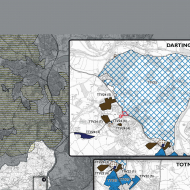TTV23 - Dartington Hall Estate
The Plymouth and South West Devon Joint Local Plan has now been adopted! To find out more please visit the Plymouth and South West Devon Joint Local Plan: Adoption page.
Visit the interactive Plymouth Plan to see other policies that affect decision making across Plymouth City including the Council and its partners.
Development at the Dartington Hall Estate (within the boundaries defined on the Policies Map), including in the order of 120 dwellings will be supported as a means of securing its long term future and to ensure the conservation of its historic buildings and landscape, where it is brought forward in line with an endorsed Estate Framework and other policies in this Plan. The Estate Framework, which will be periodically reviewed, will identify:
- The need for the development and how it will help to achieve the long-term sustainability of the Estate including the future of its historic buildings and landscape without causing harmful fragmentation of the historic entity.
- The physical, economic and environmental context.
- The significance of heritage assets within the Estate together with an overarching assessment of their condition and vulnerability now and in the future and setting out solutions for how they will be sustained, re-used, conserved and enhanced with identified priorities for investment.
- Development principles to underpin future development proposals, the broad areas for development, the type of uses proposed, and how these developments will assist in the conservation of the heritage assets identified in the framework as vulnerable or will deliver other justifiable public benefits.
- An estate-wide transport, movement and parking strategy.
- How development will be accommodated without any impact on ancient woodland in and adjacent to the site.
Planning applications for development will be required to demonstrate the following where relevant and appropriate to the scale and nature of the proposal:
- How the proposal complies with the Estate Framework.
- How the proposal addresses sustainable development by achieving economic, social and environmental gains.
- Planning applications for the development of sites within the Estate that are outside settlement boundaries should clearly demonstrate how they are contributing to securing key environmental or cultural objectives of the Trust, such as contributing financially to the reuse/repair of heritage assets.
- Where the proposal could affect the significance of a designated heritage asset, whether as a result of works to the asset or within its setting, how the development will help to secure the long term viable use of the asset and enhance the positive contribution that the asset or its setting makes, or otherwise will deliver justifiable public benefits.
- How the proposal will make a positive contribution to heritage settings and to the wider distinctiveness and character of the Estate and its landscape.
- That an archaeological assessment has been undertaken to inform and guide the development proposal.
- That a full assessment of the potential ecological impacts of the proposed development has been undertaken (including greater horseshoe bats), and, where appropriate, a mitigation plan has been prepared.
- How design standards ensure that the special architectural, historic, archaeological and artistic qualities of the Estate are retained.
- The implementation of a appropriate boundary treatment in order to retain the rural character of the wider Estate landscape.


